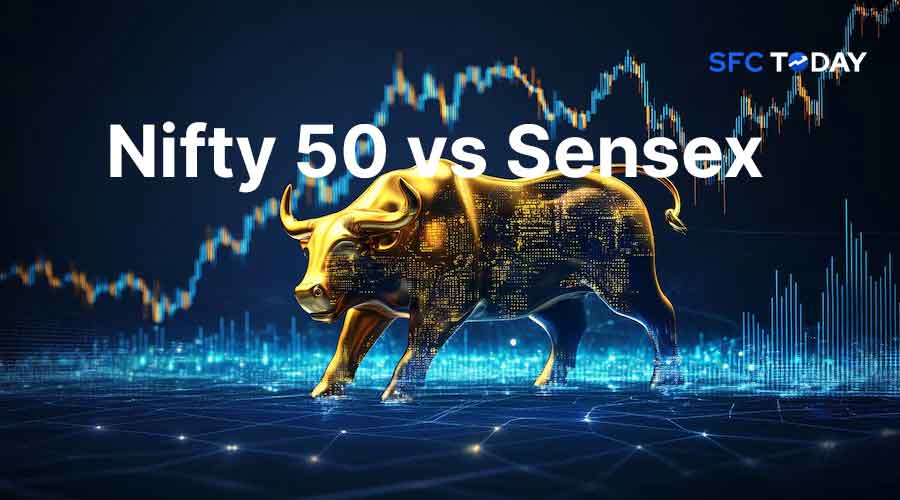Discover the ultimate showdown between India’s top market indices
India’s equity market thrives on two major benchmark indices: Nifty 50 and Sensex. These indices act as barometers for the market’s overall performance and economic health. Investors often grapple with a critical question: which index offers better stability? Analyzing their structures, historical performance, and market influence provides insights into their relative stability.
Overview of Nifty 50 and Sensex
Nifty 50
The Nifty 50, introduced by the National Stock Exchange (NSE), represents 50 companies across 14 sectors. It is calculated based on free-float market capitalization and reflects the performance of large-cap companies. These companies collectively account for a significant portion of the NSE’s total market capitalization.
Sensex
The Sensex, or the Sensitive Index, was introduced by the Bombay Stock Exchange (BSE) in 1986. It tracks the performance of 30 well-established and financially sound companies. Like the Nifty 50, it is also calculated using the free-float market capitalization method.
Key Differences Between Nifty 50 and Sensex
Number of Constituents
Nifty 50 includes 50 companies, providing broader market representation compared to Sensex’s 30 companies. The larger pool gives Nifty 50 a diversified base, potentially offering more stability.
Sectoral Distribution
Nifty 50 covers a broader range of sectors, reducing the risk of overdependence on a few industries. Sensex, with fewer constituents, may show higher sensitivity to sector-specific volatility.
Market Coverage
Nifty 50 captures approximately 65% of NSE’s market capitalization, whereas Sensex covers about 40% of BSE’s market capitalization. This broader market coverage by Nifty 50 can contribute to its stability.
Index Base Year
Sensex uses 1978-79 as its base year, while Nifty 50 uses 1995. This difference reflects their evolution over distinct economic phases, influencing their historical volatility and adaptability.
Liquidity and Trading Volume
Nifty 50 constituents often witness higher liquidity and trading volumes due to NSE’s dominance in derivatives trading. This liquidity can cushion the index during market volatility, enhancing its stability.
Analyzing Stability: Historical Performance
Volatility Trends
Historical data reveals that both indices have experienced volatility during economic downturns and global market corrections. However, Nifty 50, due to its diversified composition, often shows less extreme fluctuations compared to Sensex.
Long-Term Growth
Over the past decade, Nifty 50 and Sensex have shown similar compound annual growth rates (CAGR). Sensex tends to outperform slightly during bullish trends, while Nifty 50 demonstrates better stability during bearish phases.
Sectoral Stability
Nifty 50
With a balanced mix of industries, including IT, financials, energy, and consumer goods, Nifty 50 benefits from a diversified risk profile. For example, during the tech boom, the IT-heavy composition of Nifty 50 cushioned it against declines in other sectors.
Sensex
Sensex leans heavily on financials, IT, and energy. This concentration makes it more sensitive to sector-specific events, such as banking crises or oil price fluctuations.
Factors Influencing Stability
Constituent Companies
Nifty 50 includes more mid-to-large cap companies, while Sensex focuses exclusively on large-cap stocks. Mid-cap companies add growth potential but can also introduce volatility.
Liquidity and Market Participation
Nifty 50 benefits from NSE’s higher trading volumes and active participation in derivatives markets. This liquidity ensures quicker price adjustments and less abrupt movements.
Global Exposure
Both indices include companies with significant global footprints, such as Infosys, Reliance Industries, and TCS. These companies’ performances hinge on global economic conditions, impacting the stability of both indices.
Investor Perspective: Risk vs Reward
Investors seeking stability may gravitate toward indices with diversified portfolios and lower sectoral concentration. Nifty 50, with its broader base, offers reduced exposure to sector-specific volatility, making it more appealing to conservative investors. On the other hand, Sensex, with its focused selection of blue-chip companies, caters to those seeking exposure to well-established, financially robust firms.
Economic Indicators and Correlation
Both Nifty 50 and Sensex serve as key indicators of economic performance. Their correlation with GDP growth, inflation rates, and monetary policies makes them vital tools for assessing economic health. During periods of economic stability, both indices tend to perform steadily, though Nifty 50’s wider sectoral base provides additional cushioning against economic shocks.
Case Studies: Recent Trends
2023 Performance
Nifty 50 outperformed Sensex in terms of stability during 2023. The broader index benefited from strong performances in the IT and FMCG sectors, which offset weaknesses in energy. Sensex, with higher dependency on financials, showed more pronounced fluctuations due to banking sector challenges.
Response to Global Rate Hikes
Both indices faced headwinds during the global interest rate hikes in 2023. Nifty 50 demonstrated lower volatility due to its exposure to export-oriented sectors like IT, which gained from currency depreciation. Sensex exhibited sharper declines, reflecting the higher sensitivity of financials to interest rate changes.
Advantages of Nifty 50
Broader Representation
With 50 companies across diverse sectors, Nifty 50 minimizes the impact of poor performance in a single industry.
Higher Liquidity
Constituents often trade in large volumes, ensuring less abrupt price movements during market corrections.
Stability During Downturns
The index tends to exhibit resilience during economic downturns due to its diversified risk exposure.
Advantages of Sensex
Blue-Chip Focus
The inclusion of well-established companies provides reliability and consistency in performance.
Ease of Tracking
With fewer constituents, Sensex is easier to monitor and analyze, making it ideal for quick assessments.
Global Recognition
As one of the oldest indices in India, Sensex enjoys global recognition, attracting international investors.
Conclusion: Choosing Between Nifty 50 and Sensex
The choice between Nifty 50 and Sensex depends on investment goals and risk tolerance. Nifty 50 offers better stability through diversification, making it suitable for risk-averse investors seeking consistent returns. Sensex, with its focus on blue-chip companies, appeals to those looking for exposure to well-established firms with growth potential.
Both indices remain critical benchmarks for Indian equity markets, reflecting the health and direction of the economy. By understanding their compositions, historical performance, and sectoral dynamics, investors can make informed decisions to align their portfolios with market stability and growth opportunities.


